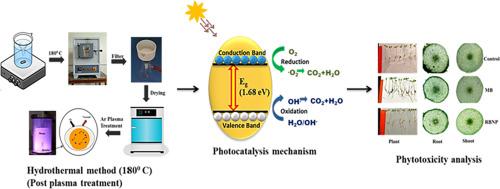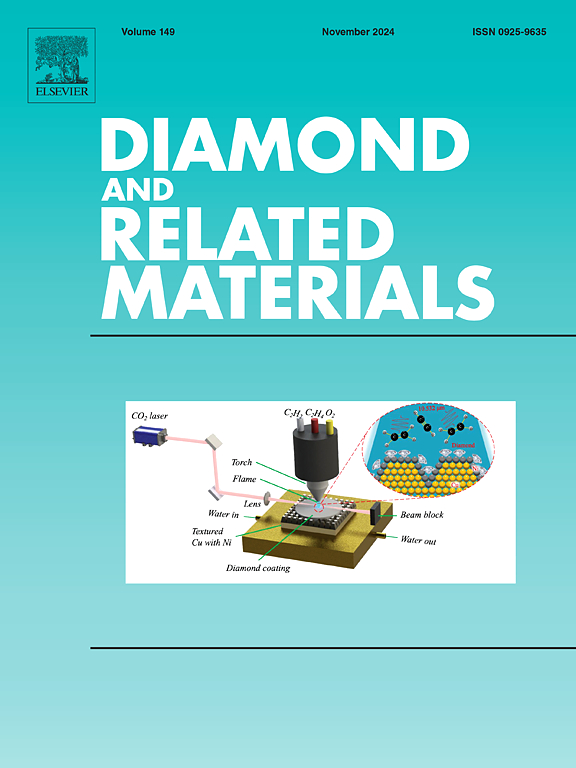Synergistic effect of argon plasma and heterojunction of g-C3N4 and GO on BiVO4 for photocatalytic application
IF 4.3
3区 材料科学
Q2 MATERIALS SCIENCE, COATINGS & FILMS
引用次数: 0
Abstract
The ternary heterojunction, BiVO4/GO/g-C3N4 was synthesized via hydrothermal method under a temperature of 180 °C. The prepared materials are post treated with glow discharge argon plasma treatment. Prepared materials shows monoclinic phase of BiVO4 and they show rod like structure. The plasma treated material shows improved degradation rate, the heterojunction after the plasma treatment (RBNP) gives 96 % of methylene blue decomposition in 180 min. The photocatalytic result is in accordance with the recombination rate of electron-hole pairs and presence of oxygen vacancies. The presence of oxygen vacancies are confirmed by XPS and EPR results. The BET analysis result confirms the presence of higher specific surface area in the plasma treated heterojunction sample, RBNP. The solution with highest degradation rate has been used for growing fenugreek plants to study the toxic effect of degraded solution on plant growth. The phytotoxicity result confirms that, the degraded solution can only slightly affect the shoot length of the plant while retaining the root length.

氩等离子体与 g-C3N4 和 GO 在 BiVO4 上的异质结的协同效应,用于光催化应用
在 180 °C 的温度下,通过水热法合成了三元异质结 BiVO4/GO/g-C3N4。制备的材料经过辉光放电氩等离子体后处理。制备的材料显示出 BiVO4 的单斜相,并呈现棒状结构。经等离子体处理的材料显示出更高的降解率,等离子体处理后的异质结(RBNP)在 180 分钟内可分解 96% 的亚甲基蓝。光催化结果与电子-空穴对的重组率和氧空位的存在相一致。XPS 和 EPR 结果证实了氧空位的存在。BET 分析结果证实,经等离子体处理的异质结样品 RBNP 具有更高的比表面积。降解率最高的溶液被用于种植葫芦巴植物,以研究降解溶液对植物生长的毒性影响。植物毒性结果证实,降解后的溶液只能轻微影响植物的芽长而保留根长。
本文章由计算机程序翻译,如有差异,请以英文原文为准。
求助全文
约1分钟内获得全文
求助全文
来源期刊

Diamond and Related Materials
工程技术-材料科学:综合
CiteScore
6.00
自引率
14.60%
发文量
702
审稿时长
2.1 months
期刊介绍:
DRM is a leading international journal that publishes new fundamental and applied research on all forms of diamond, the integration of diamond with other advanced materials and development of technologies exploiting diamond. The synthesis, characterization and processing of single crystal diamond, polycrystalline films, nanodiamond powders and heterostructures with other advanced materials are encouraged topics for technical and review articles. In addition to diamond, the journal publishes manuscripts on the synthesis, characterization and application of other related materials including diamond-like carbons, carbon nanotubes, graphene, and boron and carbon nitrides. Articles are sought on the chemical functionalization of diamond and related materials as well as their use in electrochemistry, energy storage and conversion, chemical and biological sensing, imaging, thermal management, photonic and quantum applications, electron emission and electronic devices.
The International Conference on Diamond and Carbon Materials has evolved into the largest and most well attended forum in the field of diamond, providing a forum to showcase the latest results in the science and technology of diamond and other carbon materials such as carbon nanotubes, graphene, and diamond-like carbon. Run annually in association with Diamond and Related Materials the conference provides junior and established researchers the opportunity to exchange the latest results ranging from fundamental physical and chemical concepts to applied research focusing on the next generation carbon-based devices.
 求助内容:
求助内容: 应助结果提醒方式:
应助结果提醒方式:


